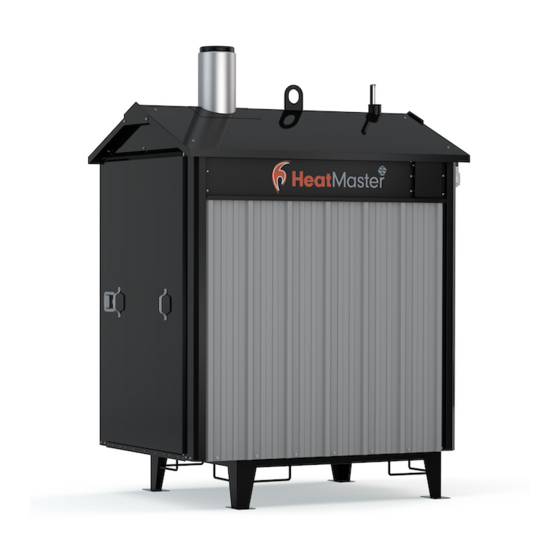
Heatmaster C Series Troubleshooting Manual
Hide thumbs
Also See for C Series:
- Operation and maintenance manual (25 pages) ,
- Operation and maintenance manual (24 pages) ,
- Operation and maintenance manual (30 pages)
Table of Contents
Advertisement
Quick Links
Troubleshooting Guide - C Series and MF eSeries
The following are just some of the common scenarios that dealers
and manufacturer's might encounter when selling outdoor furnaces.
These scenarios have come from our experiences as well as dealer
experiences. The solutions are common things to look for to solve the
problems and are not necessarily the solution to every problem. This
is meant as a helpful guide for these common problems. If anyone has
additional scenarios or information, please submit them.
If the furnace is running but fails to bring water
up to temperature:
1.
Check fire.
2.
Check fan for operation.
3.
Check that the solenoid damper and fanbox elbow is open to
allow air injection.
4.
Check to ensure the furnace is sized accurately according to
heat demand.
5.
Check fuel type. Poor quality fuel will not provide as many
BTU's as high quality fuel.
6.
Check water level of furnace.
7.
Check for ash and creosote blockage at chimney and bypass
trough.
8.
Check for blockage in venting and at the rear of the ash
container where the air enters the firebox.
9.
Check temperature settings. Make sure high temperature
setting is set to at least 165 F.
10. Check for power at furnace.
11. Check to ensure all pumps in the system are running.
12. Check to make sure there are no leaks, hot/wet spots on your
ground or breaks in the pipe or fittings which may cause the
pipe to be saturated and lose its insulation value.
13. Check Temperature of water exiting furnace, entering the
building being heated and before and after each heat
exchanger.
If the furnace water is hot but buildings do not
have heat:
1. Check to ensure all pumps in the system are running.
2. Check filter cartridge for flow blockage (if installed).
3. Check for air in the system at the exchanger by bleeding off.
4. Check for closed valves to ensure water flow.
5. Check Temperature of water exiting furnace, entering the
building being heated and before and after
each heat exchanger.
If the furnace overheats:
1. Check that all doors are closing properly and that door gasket
is completely sealing.
2. Check that the solenoid damper plate is opening and closing
without hang-ups.
3. Check venting and fan box on rear of furnace for air leaks.
4. Check that the temperature settings are correct. The furnace
should be set on Heating Mode (H1) and the high temperature
setting should be set to no higher than 185 F.
5. Check chimney draft. If the chimney has been extended too far
or has a strong wind blowing over it, it may cause a draft down
the furnace.
6. Check water level.
7. Make sure the door and ash drawer are air tight.
8. Check to ensure all pumps in the system are running.
If the furnace has shut down:
1. Check to ensure that the unit has power (does the light work?).
2. Check to ensure the Furnace On/Off switch is in the On
position.
3. Check the water temperature (furnace has a high temperature
cut out of 190 degrees F. and turns on again at 140 degrees).
4. If all checks have not corrected the problem have a technician
check the control panel.
If there is a chimney fire:
1. Make sure the firebox and ash pan doors are tightly closed.
2. Close all combustion air inlets on the furnace.
If there is a power failure:
1. Open all flow-check and zone valves in the system. Depending
on the system design, this may allow convective circulation.
NOTE: This does not apply to gravity systems, as they have no
flow-check valves and will continue to operate normally without
electricity.
2. It is important to remember that the heating systems cannot
dispose of a great deal of heat without the circulator(s) running.
Avoid over-firing!
Advertisement
Table of Contents
Troubleshooting

Subscribe to Our Youtube Channel
Summary of Contents for Heatmaster C Series
- Page 1 Troubleshooting Guide - C Series and MF eSeries The following are just some of the common scenarios that dealers 5. Check Temperature of water exiting furnace, entering the and manufacturer’s might encounter when selling outdoor furnaces. building being heated and before and after These scenarios have come from our experiences as well as dealer each heat exchanger.
- Page 2 Having to fill the furnace with water more DO NOT LOAD LARGE AMOUNTS OF SOLID FUEL INTO thanonce a week or more then a few THE FURNACE! gallons of water per week and there is no Fire the furnace cautiously until you are able to determine how obvious explanation quickly the heat system is able to absorb the heat being produced by the furnace.
- Page 3 Electronic Temperature Control Settings & Specifications Description Step Indicator Description The Ranco Electronic temperature control (ETC) is designed to F or C Fahrenheit or Celsius Scale provide on/off control for heating and cooling. It is equipped with a S1 blinking Setpoint Temperature liquid crystal display (LCD) that provides a constant readout of the DIF1 blinking Differential Temperature sensed temperature, and a touch keypad that allows the user to easily and accurately select the set of point temperature, differential and C1/H1 Cooling or Heating Mode...
- Page 4 Electronic Timer Control and Settings Description The OFF Timer can be set to run in hours, minutes or seconds. The first two DIP switches will control what The electronic timer uses the fan to inject air into the the time setting will be. firebox in set intervals.










Need help?
Do you have a question about the C Series and is the answer not in the manual?
Questions and answers